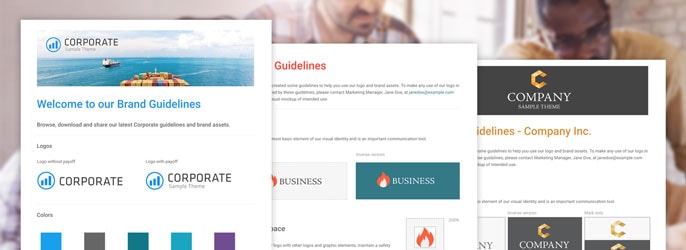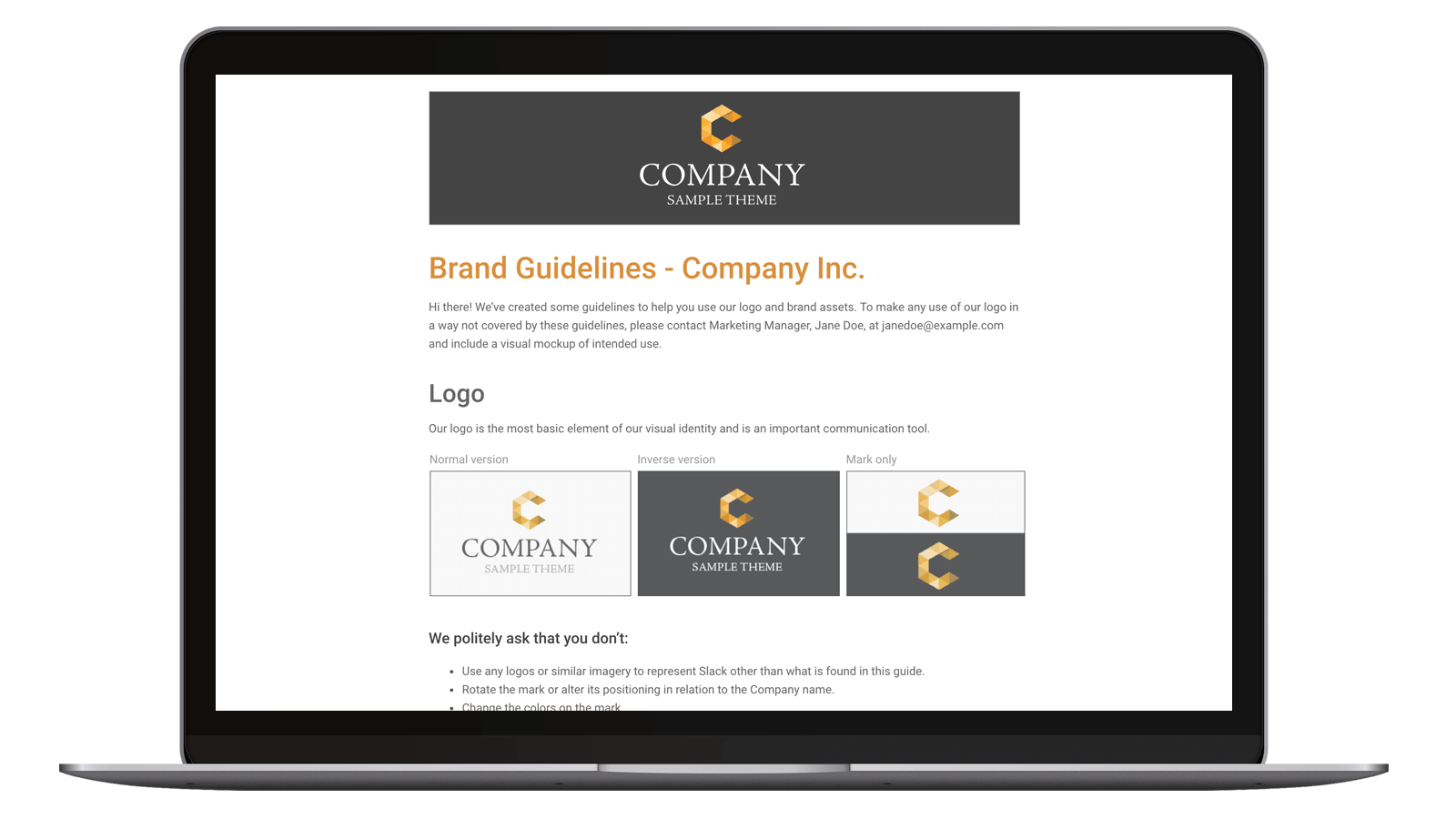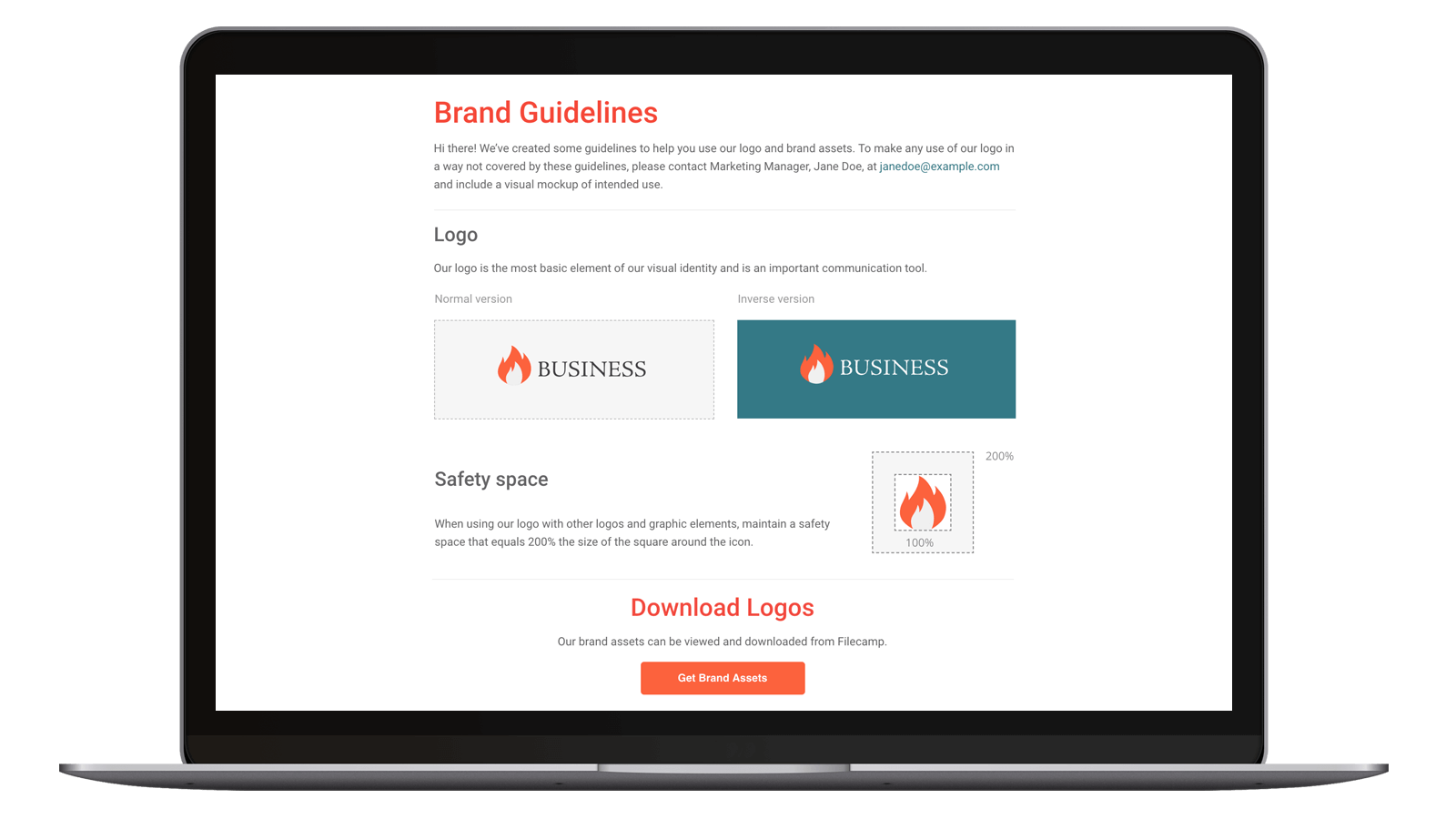Some must-have items for your online brand guidelines kit
Brand guidelines help you share your brand with the world. When the press or an online publication wants to feature your business, it helps to have your logo and instructions on using it easily accessible. When you’re partnering with other companies it also helps to have photos of our executive staff ready for press releases.
A set of brand guidelines in a style guide or brand guidelines kit gives your business the best chance of looking good in joint ventures with partners and the press. In addition to logos and photos, your brand guidelines can also include which fonts your brand uses and what your social media pages look like.
Many SMEs don’t have all their brand assets in one place. It sounds odd, but it’s true. Brand asset management is the name for the system of gathering all the important logos, photos, and information for your business. With Filecamp you get a complete brand asset management system. You can easily create a set of brand guidelines using Filecamp.
In fact, we’ve set up every Filecamp trial with a set of sample brand guidelines you can customize and replace and create your own brand style guide.
Some must-have items for your online brand guidelines
Brand guidelines can be very elaborate, with instructions and illustrations spanning hundreds of pages. But most companies can make do with much less. And with Filecamp it is very easy to set up your own online brand guidelines kit. Below is what we recommend for a bare-bones brand guidelines kit.
Brand guidelines – the basics
It’s imperative that brand guidelines clearly express the identity of your brand and remain consistent across all aspects. This means the same typography on the logo, on the website, on your business cards, and so on. It means that your websites and apps follow the same overall structure and styling. It doesn’t mean that you and your creative team cannot design interesting variations of your brand. For instance, you might want to make a version of your logo to promote a specific sporting event or an upcoming holiday season.
To clarify brand guidelines, try to create a document that defines general usage. For example, to define the typography of a blog post on your website, you’ll most likely specify 2-3 distinctive fonts and/or sizes; the title of the post will typically be larger; the header (Headline 1) of the post will be a different size; the subheaders will be smaller; and so on.
But, consistency is key and it’s important that the brand remains true to its roots.
Brand overview
For the sake of company teams that are not involved in marketing (IT teams for example) be sure to include:
- A mission statement or company overview explaining the company vision
- Any videos that define your product or service
- Sample corporate materials
![]()
Color palette
The color palette should contain the basic color scheme used for your websites, apps and any templates or promotional materials. In many cases, it should also contain secondary color schemes (additional colors) that are used peripherally, say for company mascots vs. the standard logo.
Be sure to include:
- Primary color palette
- Secondary color palette
- Photo or illustration style
Provide Pantone (PMS), RGB, HEX, and CMYK equivalents of the colors in your color palette for varied uses.
![]()

Fonts
Company fonts should include all variations of website and app fonts which often differ from printed fonts. Be sure to include:
- Typography style
- Corporate typefaces
- Supporting elements
- Spacing requirements
- Font colors
Include typeface size, line height, etc. Be sure to specify fonts that can be used in header vs. body text, online, offline, and so on.
![]()

Logos
Logos are the entryway to your entire brand identity. Specify placement and add alternative versions. Be sure to include:
- Primary logo
- Horizontal and vertical representations of your logo with and without tagline, as needed
- Secondary and supporting logos (e.g. black & white logo, transparent logo)
- Varying logo sizes (color: preferred and variations; positive, reverse, 4-color, 1-color)
- Product names/logos where applicable
- Acceptable logo sizes and variation sizes
- Square version of the logo (if the original logo is not square)
Infographics
Infographics are an integral part of a brand identity. They help companies build authority, and present a visual representation that helps users understand complex data. Infographics can easily go viral, be used in presentations, attract backlinks and help generate higher traffic. Be sure to include all key infographics related to your brand:
- Products or services and their position in your industry
- Process flow
- Step by step instructions
- Statistical analysis told in images
Screenshots
Web and app screenshots are important to include, because while marketing, graphic designers, and webmasters might know your website and apps backwards and forwards, an executive assistant (for example) may never enter that portal and be unfamiliar with the user interface. In fact, there can be entire teams within your company who have limited interaction with parts of your website and the product itself. Be sure to include:
- Screenshots of the website. If your website has multiple templates, include screenshots of all of them.
- Product/app design and interface (be sure to include any mobile app screenshots as well).
Products
This section is often available publicly, used on site, included in company materials like brochures, marketplaces, etc. Be sure to include:
- Quality images – high resolution
- Multiple product images
- Provide a document or caption explaining what each product is and what it’s used for
(Also provide a document with short lines of text describing each image, which your webmaster can use as meta tags when they upload the images for you. This is important for SEO purposes.)
Social media
Today, social media icons are a major aspect of a brand identity. If you have specially designed social media icons for your
website, add them so your team knows not to use the de facto generic versions.
Be sure to include:
- Social icons – web and app style
- Twitter profile background
- Facebook background
- Other social media profile backgrounds and images
Executive team
Headshots of key company leaders are integral. These images are used on site, for the press, for mission statements and even for investment outreach efforts. Be sure to include images, names and titles of key company leaders such as:
- Founders
- Board members/advisors
- CEO
- CFO
- CTO
- CMO
Layout and templates
Templates are important for teams in order to maintain consistency company-wide in all types of communication, from accounting forms to white papers to business cards. Be sure to include templates and requirements for:
- Product catalogs
- Brochures
- Product spec sheets
- Customer case studies
- Whitepapers
- Press releases
- Video introductions and closings
- Purchase orders
- Invoices
- Ads (printed or online)
- Trade show and event displays
- Packaging
- Promotional items
- Email signatures
- Stationery
- Business cards, standard
- Letterhead, standard
- Envelopes
- Any Microsoft® Office templates: Word®, Excel®, PowerPoint®, Visio®
How to add your brand guidelines into your Filecamp brand portal
When you have your free demo account set up, you can easily replace our example files and images with your own.
You should then replace our recommended placeholder files with your company-branded materials. Share with your friends!
Do you know a fellow marketer or startup who could also benefit from our easy brand guidelines kit? Spread the word on Twitter, Facebook, or set up your free trial with Filecamp now.
Share this Post


